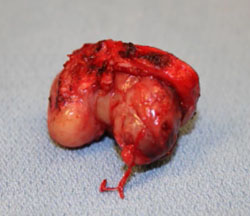ALERT!
This site is not optimized for Internet Explorer 8 (or older).
Please upgrade to a newer version of Internet Explorer or use an alternate browser such as Chrome or Firefox.
Tracheal Resection for Tumor
The patient is a 42-year-old male who presented to the emergency department with stridor. CT revealed a broad-based tumor 4 cm distal to the vocal cords and 7 cm proximal to the carina (Figure 1). The tumor was biopsied by bronchoscopy and pathology was suggestive of a schwannoma.
A cervical approach was planned for the resection. The patient’s airway was dilated and intubated with an armored single lumen endotracheal tube. Cervical flaps were raised and the thyroid gland was divided in the midline to expose the underlying trachea. Intraoperative bronchoscopy with needle localization was used to identify the distal extent of the tumor. The trachea was then divided and the endotracheal tube was pulled back to facilitate exposure of the trachea for resection. A suture was placed in the endotracheal tube to facilitate repositioning after completion of the posterior aspect of the anastomosis. The patient’s airway was controlled with cross-field ventilation using a second sterile single lumen endotracheal tube and intermittent periods of apnea when necessary. Bipolar cautery was used to minimize risk of damage to the recurrent laryngeal nerves. The proximal and distal extent of the tumor was resected.
Corner stitches were placed at the left and right membranous-cartilaginous junctions to align the proximal and distal segments of trachea. The membranous trachea was closed using a running suture which was secured to the corner stitches. The remainder of the trachea was closed using simple interrupted sutures. The endotracheal tube was pulled down and repositioned before the front wall of the trachea was approximated. The anastomosis was checked for leaks and incisions closed. A chin stitch was placed to maintain the neck in flexion to prevent postoperative tension for four days.







Comments